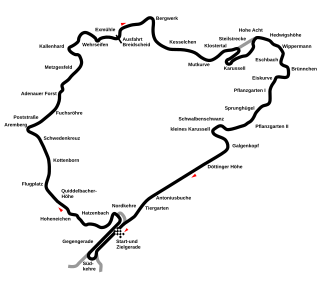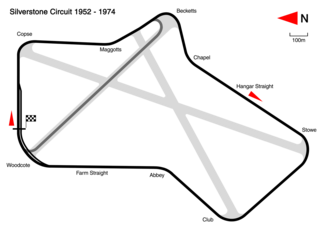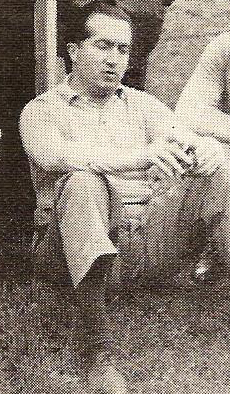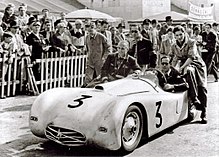
Alberto Ascari was an Italian racing driver, who competed in Formula One from 1950 to 1955. Ascari won two Formula One World Drivers' Championship titles, which he won in 1952 and 1953 with Ferrari, and won 13 Grands Prix across six seasons. In endurance racing, Ascari won the Mille Miglia in 1954 with Lancia.

The 1951 French Grand Prix was a Formula One motor race held at Reims-Gueux on 1 July 1951. It was race 4 of 8 in the 1951 World Championship of Drivers and was won by Juan Manuel Fangio and Luigi Fagioli driving an Alfa Romeo. It was the first of three occasions where two drivers would be credited with a Grand Prix win after sharing a car.

The 1951 German Grand Prix was a Formula One motor race held on 29 July 1951 at the Nürburgring Nordschleife. It was race 6 of 8 in the 1951 World Championship of Drivers.

The 1951 Italian Grand Prix was a Formula One motor race held on 16 September 1951 at Monza. It was race 7 of 8 in the 1951 World Championship of Drivers.

The 1952 Swiss Grand Prix was a Formula Two race held on 18 May 1952 at Bremgarten Circuit. It was the first round of the 1952 World Championship of Drivers, in which each Grand Prix was run to Formula Two rules rather than the Formula One regulations normally used.

The 1952 French Grand Prix was a Formula Two race held on 6 July 1952 at Rouen-Les-Essarts. It was race 4 of 8 in the 1952 World Championship of Drivers, in which each Grand Prix was run to Formula Two rules rather than the Formula One regulations normally used. Unusually this race was run over a duration of 3 hours, rather than a fixed distance.

The 1952 British Grand Prix was a Formula Two race held on 19 July 1952 at Silverstone Circuit. It was race 5 of 8 in the 1952 World Championship of Drivers, in which each Grand Prix was run to Formula Two rules rather than the Formula One regulations normally used.

The 1952 German Grand Prix was a Formula Two race held on 3 August 1952 at the Nürburgring Nordschleife. It was race 6 of 8 in the 1952 World Championship of Drivers, in which each Grand Prix was run to Formula Two rules rather than the Formula One regulations normally used. The 18-lap race was won by Ferrari driver Alberto Ascari after he started from pole position. His teammates Giuseppe Farina and Rudi Fischer finished in second and third places.

The 1952 Dutch Grand Prix was a Formula Two race held on 17 August 1952 at the Circuit Zandvoort. It was race 7 of 8 in the 1952 World Championship of Drivers, in which each Grand Prix was run to Formula Two rules rather than the Formula One regulations normally used. The 90-lap race was won by Ferrari driver Alberto Ascari after he started from pole position. His teammates Giuseppe Farina and Luigi Villoresi finished in second and third places. Ascari overtook Fangio's record for the most race wins, scoring his seventh at this race.

The 1952 Italian Grand Prix was a Formula Two race held on 7 September 1952 at Monza. It was the eighth and final round of the 1952 World Championship of Drivers, in which each Grand Prix was run to Formula Two rules rather than the Formula One regulations normally used. The 80-lap race was won by Ferrari driver Alberto Ascari after he started from pole position. José Froilán González finished second for the Maserati team and Ascari's teammate Luigi Villoresi came in third.

The 1953 Argentine Grand Prix was race 1 of 9 in the 1953 World Championship of Drivers, which was run to Formula Two regulations in 1952 and 1953. The race was held in Buenos Aires on 18 January 1953, at the Autódromo Gálvez and was the first World Drivers' Championship race in South America.

The 1953 Dutch Grand Prix was a Formula Two race held on 7 June 1953 at the Circuit Zandvoort. It was race 3 of 9 in the 1953 World Championship of Drivers, which was run to Formula Two rules in 1952 and 1953, rather than the Formula One regulations normally used. The 90-lap race was won by Ferrari driver Alberto Ascari after he started from pole position. His teammate Nino Farina finished second and Maserati drivers José Froilán González and Felice Bonetto came in third

The 1953 Belgian Grand Prix was a Formula Two race held on 21 June 1953 at Circuit de Spa-Francorchamps. It was race 4 of 9 in the 1953 World Championship of Drivers, which was run to Formula Two rules in 1952 and 1953, rather than the Formula One regulations normally used. The 36-lap race was won by Ferrari driver Alberto Ascari after he started from second position. His teammate Luigi Villoresi finished second and Maserati driver Onofre Marimón came in third.

The 1953 French Grand Prix was a Formula Two race held on 5 July 1953 at Reims. It was race 5 of 9 in the 1953 World Championship of Drivers, which was run to Formula Two rules in 1952 and 1953, rather than the Formula One regulations normally used.

The 1954 Belgian Grand Prix was a Formula One motor race held at Spa-Francorchamps on 20 June 1954. It was race 3 of 9 in the 1954 World Championship of Drivers. The 36-lap race was won by Maserati driver Juan Manuel Fangio after he started from pole position. Maurice Trintignant finished second for the Ferrari team with Fangio's teammate Stirling Moss in third.

The 1954 Formula One season was the eighth season of FIA Formula One motor racing. It featured the fifth World Championship of Drivers, which was contested over nine races between 17 January and 24 October 1954. The season also included several non-championship races for Formula One cars.

The 1952 Formula One season was the sixth season of FIA Formula One motor racing. It featured the 3rd World Championship of Drivers, which was contested over eight races between 18 May and 7 September 1952. The season also included several non-championship races and a separate East German Championship.

The 1951 Formula One season was the fifth season of FIA Formula One motor racing. It featured the second World Championship of Drivers, which was contested over eight races between 27 May and 28 October 1951. The season also included several non-championship races for Formula One cars.

The 1952 24 Hours of Le Mans was the 20th Grand Prix of Endurance, and took place on 14–15 June 1952 at Circuit de la Sarthe.

The Ferrari 500 was a Formula 2 racing car designed by Aurelio Lampredi and used by Ferrari in 1952 and 1953, when the World Championship was run to F2 regulations.


















